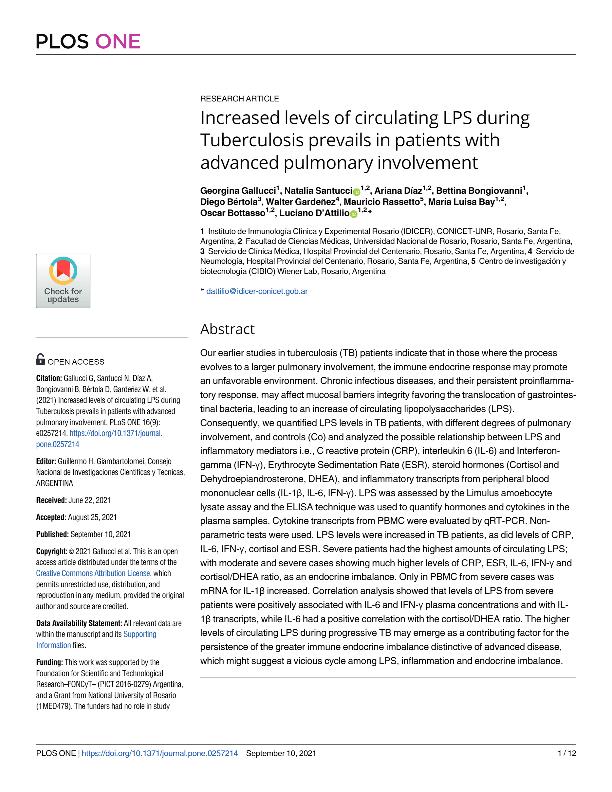Artículo
Increased levels of circulating LPS during Tuberculosis prevails in patients with advanced pulmonary involvement
Gallucci, Georgina Florencia ; Santucci, Natalia Estefanía
; Santucci, Natalia Estefanía ; Díaz, Ariana
; Díaz, Ariana ; Bongiovanni, Bettina
; Bongiovanni, Bettina ; Bértola, Diego; Gardeñez, Walter; Rassetto, Mauricio; Bay, Maria Luisa; Bottasso, Oscar Adelmo
; Bértola, Diego; Gardeñez, Walter; Rassetto, Mauricio; Bay, Maria Luisa; Bottasso, Oscar Adelmo ; D'attilio, Luciano David
; D'attilio, Luciano David
 ; Santucci, Natalia Estefanía
; Santucci, Natalia Estefanía ; Díaz, Ariana
; Díaz, Ariana ; Bongiovanni, Bettina
; Bongiovanni, Bettina ; Bértola, Diego; Gardeñez, Walter; Rassetto, Mauricio; Bay, Maria Luisa; Bottasso, Oscar Adelmo
; Bértola, Diego; Gardeñez, Walter; Rassetto, Mauricio; Bay, Maria Luisa; Bottasso, Oscar Adelmo ; D'attilio, Luciano David
; D'attilio, Luciano David
Fecha de publicación:
09/2021
Editorial:
Public Library of Science
Revista:
Plos One
ISSN:
1932-6203
Idioma:
Inglés
Tipo de recurso:
Artículo publicado
Clasificación temática:
Resumen
Our earlier studies in tuberculosis (TB) patients indicate that in those where the process evolves to a larger pulmonary involvement, the immune endocrine response may promote an unfavorable environment. Chronic infectious diseases, and their persistent proinflammatory response, may affect mucosal barriers integrity favoring the translocation of gastrointestinal bacteria, leading to an increase of circulating lipopolysaccharides (LPS). Consequently, we quantified LPS levels in TB patients, with different degrees of pulmonary involvement, and controls (Co) and analyzed the possible relationship between LPS and inflammatory mediators i.e., C reactive protein (CRP), interleukin 6 (IL-6) and Interferon-gamma (IFN-γ), Erythrocyte Sedimentation Rate (ESR), steroid hormones (Cortisol and Dehydroepiandrosterone, DHEA), and inflammatory transcripts from peripheral blood mononuclear cells (IL-1β, IL-6, IFN-γ). LPS was assessed by the Limulus amoebocyte lysate assay and the ELISA technique was used to quantify hormones and cytokines in the plasma samples. Cytokine transcripts from PBMC were evaluated by qRT-PCR. Nonparametric tests were used. LPS levels were increased in TB patients, as did levels of CRP, IL-6, IFN-γ, cortisol and ESR. Severe patients had the highest amounts of circulating LPS; with moderate and severe cases showing much higher levels of CRP, ESR, IL-6, IFN-γ and cortisol/DHEA ratio, as an endocrine imbalance. Only in PBMC from severe cases was mRNA for IL-1β increased. Correlation analysis showed that levels of LPS from severe patients were positively associated with IL-6 and IFN-γ plasma concentrations and with IL-1β transcripts, while IL-6 had a positive correlation with the cortisol/DHEA ratio. The higher levels of circulating LPS during progressive TB may emerge as a contributing factor for the persistence of the greater immune endocrine imbalance distinctive of advanced disease, which might suggest a vicious cycle among LPS, inflammation and endocrine imbalance.
Palabras clave:
Tuberculosis
,
LPS
,
Severidad
,
Relación inmuno-endócrina
Archivos asociados
Licencia
Identificadores
Colecciones
Articulos(IDICER)
Articulos de INSTITUTO DE INMUNOLOGIA CLINICA Y EXPERIMENTAL DE ROSARIO
Articulos de INSTITUTO DE INMUNOLOGIA CLINICA Y EXPERIMENTAL DE ROSARIO
Citación
Gallucci, Georgina Florencia; Santucci, Natalia Estefanía; Díaz, Ariana; Bongiovanni, Bettina; Bértola, Diego; et al.; Increased levels of circulating LPS during Tuberculosis prevails in patients with advanced pulmonary involvement; Public Library of Science; Plos One; 19; 9; 9-2021; 1-12
Compartir
Altmétricas



